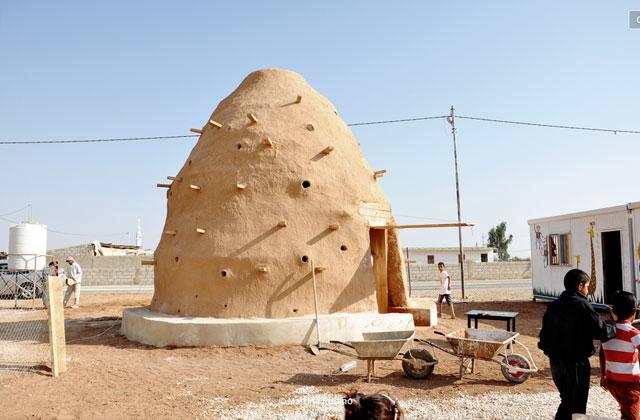You are here
Classrooms built by refugees for refugees win world architecture award
By Camille Dupire - Feb 12,2018 - Last updated at Feb 12,2018

‘The Dome’ as the residents call it, serves as a classroom for children of the Zaatari village (Photo courtesy of EAHR / Martina Rubino)
AMMAN — Stricken by the realisation that two out of three refugee children tend to drop out of education due to the lack of schools located near their house, the international organisation Emergency Architecture and Human Rights (EAHR) decided to launch its “100 Classrooms and Football fields” project.
In September 2017, EAHR finished its first classroom built in Zaatari village in partnership with the local organisation founded by a Syrian refugee: Acting for Change.
“When we visited Jordan in 2014, we realised that most of the problems related to education are outside and not inside the camps. Because they do not attract as many international NGOs and visibility, host communities are in dire need of assistance, especially in terms of number and quality of schools,” said EAHR Director Michele di Marco, explaining the reason behind the choice of Zaatari village rather than Zaatari camp for their first project.
Convinced that refugees know better than anyone else what their peers need, EAHR and Acting for Change started conducting consultation sessions with the local communities, who pointed out the need for cheap, weather adapted venues.
“In their situation, refugees need simple, fast, low cost and sustainable solutions, which is what we are providing with these classrooms,” di Marco told The Jordan Times, referring to the SuperAdobe technique used in the project.
SuperAdobe is a form of earth bag architecture developed by architect and CalEarth founder Nader Khalili. Using long sandbags, barbed wire, on-site earth and a few simple tools, the revolutionary building system has been published by NASA and endorsed by the United Nations, according to online sources.
“Due to the limited choice of building methods and materials, as well as the harsh environment characterised by hot summers and cold winters, traditional building techniques are not viable options for school construction,” explained Hanin Abu Mahfouz, an engineer working with Oxfam Jordan on a similar project in Zaatari.
The SuperAdobe design, however, helps gain four to five degrees in the winter and lowers the temperature by six to seven degrees in the summer, compared to traditional buildings, she explained.
Based on a localised construction process, which directly involves the refugee community and uses entirely locally produced material, the “100 classrooms” project steps away from the externally built aid scheme.
The average cost to build one classroom is 5,000 Euros, half of which is spent to purchase material, while the other half is distributed as salaries to the local workers.
“This way, we also help in providing livelihood for the underprivileged host communities and refugees,” the architect said.
“Most of these people used to work with these materials back in Homs, so they know how to handle them. They just needed a bit of professional help with the typology and the building technique,” di Marco explained, recalling, however, the initial skepticism of some local residents.
Ninety-eight-year-old refugee Um Sultan recalled: “I used to make the plaster of our house every year. We used mainly soil and water and mixed it with straws. Straws make the structure more resistant, especially when it rains.”
The technical knowledge of some refugees, combined with the internationally recognised design account for the great success of the first project. A month after its completion, “the Dome”, as Zaatari residents call it, was awarded the first prize for outstanding professionalism at the XX Architecture and Urbanism Biennial in Chile, the second most important contest in the field.
It was also declared “Building of the Year” by Archdaily, the biggest architectural platform worldwide.
“It is amazing to see that a construction built by refugees for refugees has won this prestigious award, as they were competing against some of the best architects in the world,” di Marco rejoiced, noting that some more privileged Jordanians have since approached some of the refugees and vulnerable Jordanians who worked on the SuperAdobe to have them build summer houses in the countryside.
“At times of war, most people do not have any contact with architects and there is a belief that architecture is a luxury. But we believe that refugees are clients like any others, we are not humanitarian architects, we strive to provide them with the best quality and the best standards available,” the EAHR director stressed.
The organisation is now planning to start two more projects in Ahraba and Azraq as soon as they collect enough funding, with the aim of benefiting even more children.
Ahmed Khalaf Al-Addad, a Syrian refugee who used to teach first to sixth graders back in Syria, expressed his joy at seeing such classrooms being built for local children.
“When I saw children in the street, I wanted to open a voluntary school for them so we can teach them how to read and write at least,” said the man, who has been teaching refugee children and following up on students who dropped out of school for over four years with the help of other local volunteers.
“Syrian children and youth are at the verge of being a lost generation with a severe decrease in quality of life and a vivid perception of social injustice. We believe that education is key in creating change and strive to see every child having the right to education and the right to play,” di Marco concluded.
Related Articles
ZAATARI — Residents of Zaatari’s eighth district now have the chance to enjoy a comfortable, entertaining summer, as Oxfam recently inaugura
AMMAN — Oxfam has recently engaged several Syrian children at the Zaatari Refugee Camp, over 80km northeast of Amman, in a recycling initiat
Hundreds of years after wealthy merchants began building the tall, narrow brick houses that have come to define Amsterdam’s skyline, Dutch architects are updating the process for the 21st century: fabricating pieces of a canal house out of plastic with a giant 3-D printer and slotting them together like oversized Lego blocks.
















